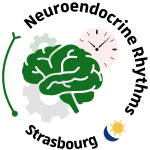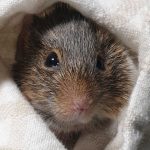Regulation and disruption of neuroendocrine rhythms
Etienne CHALLET & Valérie SIMONNEAUX

Presentation
 Team 7 objectives are to tackle the issue of organism’s adaptation or maladaptation to environmental changes, taking advantage of the biodiversity of physiological processes used by various animal species.
Team 7 objectives are to tackle the issue of organism’s adaptation or maladaptation to environmental changes, taking advantage of the biodiversity of physiological processes used by various animal species.
Team members investigate the mechanisms of daily and seasonal synchronization of metabolic and reproductive functions, and evaluate the impact of environmental perturbations (nocturnal light exposure, acute or chronic time shifts, unbalanced diet, endocrine disruptors) on these rhythmic functions.
These investigations will be conducted with a comparative approach on a variety of conventional (rat, mouse) and non-conventional (planarian, diurnal and seasonal rodents, large mammals) animal models.
1. Basics in neuroendocrine rhythms
This axis aims at identifying the neuroendocrine mechanisms through which the brain and peripheral clocks control the rhythmicity of physiology to ensure the proper adaptation of species to their rhythmic environment. More specially, we study two highly integrated physiological processes, namely energy metabolism and reproduction. On the one hand, we investigate how cerebral clocks regulate the daily feeding/fasting cycle and food anticipation, and how these clocks are reset by feeding and arousing cues in both nocturnal and diurnal animal models. On the other hand, we investigate how the hypothalamus regulates daily/ovarian/seasonal reproductive cycles, but also seasonal adaptation via hibernation, neurogliogenesis and maternal programming.
1.1. Functional links betwen brain clocks and nutritional and arousing cues
Sylvie Raison, Stéphanie Dumont, Patrick Vuillez, Etienne Challet
1.2. Neuroendocrine mechanisms regulating seasonal functions
Valérie Simonneaux, Paul Klosen, Aurélia Ces, Vincent Joseph Poirel, Vebjorn Melum, Louise Sicot
2. Impact of environmental perturbations on neuroendocrine rhythms
This axis aims at understanding the impact of environmental perturbations (nocturnal light exposure, acute or chronic time shifts, unbalanced diet, endocrine disruptors, magnetic and electromagnetic fields) on rhythmic functions. Our working hypothesis is that the synchronising factors able to reset circadian clocks, become desynchronizers when they are perceived/provided at the wrong times of the daily cycle, thus triggering or favouring adverse health effects. Further, as seasonal functions depend on finely regulated hormone secretion and action, we hypothesize that disruption of this hormonal orchestra by physical cues or exogenous chemicals may alter organisms’s seasonal adaptation.
2.1. Effect of disrupted light-dark cycles (shift work and light at night)
Etienne Challet, Valerie Simonneaux, Stéphanie Dumont, Nathalie Jeandidier, Thibault Bahougne, Marine Simonneaux, Emma Grosjean
2.2. Effect of unbalanced diets
Clémentine Fillinger, Stéphanie Dumont, Patrick Vuillez, Etienne Challet
2.3. Effect of endocrine disruptors on rhythms in reproduction and metabolism
Valérie Simonneaux, Paul Klosen
2.4. Effects of magnetic and electromagnetic fields on circadian rhythms
Hervé Cadiou, Yannick Menger, Guillaume Reho

Paul Klosen
(MCU Unistra)

Valérie Simonneaux
(DR CNRS)

Patrick Vuillez
(MCU Unistra)

Yannick Menger
(CDD AI 100%)

(Ph. D.)
The population is increasingly exposed to nocturnal light pollution, particularly employees working atypical hours. Previous studies indicate that shift work increases the risk of metabolic disorders and disrupts fertility. However, it is still difficult to separate the direct impact of light at night (LAN) from the impact of desynchronization of the circadian system. Moreover, the effects of light pollution have been little studied in females, despite the increasing number of women working shift work. The aim of this project was to assess the impact of nocturnal light pollution on the metabolism and fertility of a female diurnal rodent, Arvicanthis ansorgei, whose circadian clocks are similar to those of women.
(co-supervised by E. Challet & V. Simonneaux)
Guillaume Reho (Ph. D.):
Pain can be defined by two components : a sensory one and an emotional one. The sensorial component is what we call nociception. It represents all receptors and nervous cells that react when a tissue is submitted to noxious stimuli. Nociception is largely studied in vertebrates but is also present in lots of invertebrate animals, which are under-represented. It is in this context that my thesis is interested in the nociception of planarians, which are small freshwater flatworms, and the way in which we can modulate their reactions to noxious stimuli, just as analgesics do to us. Studying nociception in invertebrates allows us to better understand how pain formed during evolution and what its fundamental properties are, thus allowing us to better treat it.
(supervised by H. Cadiou)

(Ph. D.)
I am studying seasonal variations in cell proliferation in a specific region of the brain, the hypothalamus. This region is involved in the regulation of physiological functions such as reproduction and energy metabolism. My thesis project carried out in the Syrian hamster, a seasonal rodent model, aims to identify the seasonal signals regulating hypothalamic cell proliferation, determine the cellular mechanisms involved, and characterize the physiological role of seasonality in hypothalamic cell proliferation.
(supervised by V. Simonneaux)

(Ph. D.)
In female mammals, the reproductive function displays cycles whose regularity depends on a functional circadian system. This is illustrated by the synchronization of the preovulatory luteinizing surge (LH) with the onset of the active period at the end of the follicular phase, which enables ovulation to occur at the appropriate time for successful fertilization. The coordination of the hormonal and circadian signals is essential for this synchronization because light-induced disruption of circadian rhythms can negatively impact female reproductive function. In this context, my thesis project aims to investigate the central and peripheral mechanisms by which circadian disruption alters the female mice’s reproductive function and to develop a clinical research protocol to assess the consequences of shift work in women.
(supervised by V. Simonneaux)

(Ph. D.)
Wild species are exposed to strong seasonal variations in their environment. I study the neuroendocrine mechanisms involved in physiology’s anticipation of these environmental variations. In particular, I study the role of tanycytes in seasonal maternal programming and in hibernation cycles.
(co-supervised V. Simonneaux & S. Wood)



























